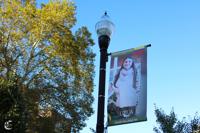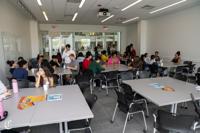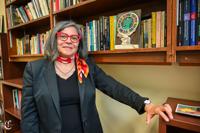The perpetuation of negative stereotypes about Hispanic people remains a challenge on college campuses nationwide, influencing how students experience classroom discussions, social life and their sense of belonging.
At Penn State, those challenges surface in classrooms and campus culture, where efforts to counter bias and promote inclusion are still beginning to take shape.
Maria Lopez, a third-year studying political science and economics, was born in Puerto Rico and completed twelve years of schooling in Peru before moving to North Carolina three years ago. She said she still struggles with finding her place in the United States.
“It becomes even harder when you go into a community that is predominantly white,” Lopez, the justice and equity chair and a Latino Caucus representative and for the University Park Undergraduate Association (UPUA), said. “I love this university, but sometimes I wish I would have known more about how to adapt to an environment like this.”
A banner from the University Park Undergraduate Association (UPUA) hangs above East College Avenue on Wednesday, Oct. 1, 2025 in State College, Pa.
Lopez said Penn State being a predominantly white institution (PWI) gives her and other Hispanic students the room to bring diversity to campus, and allowing white students to hear other perspectives “enriches their experiences too.”
On the other hand, being a minority at a school largely composed of white students means Lopez has experienced racism at the hands of her peers.
Lopez said during her freshman year, a white, male student insinuated that Lopez’s parents were lower-class, and she was a first-generation student. In reality, Lopez’s mother is a chemical engineer, and her father has worked at Wells Fargo for the past 15 years.
“They assumed that my parents have no education and I came from a family who didn’t have a background in education,” Lopez said. “It’s hard, and it was definitely a shock for me, as somebody who is so proud of where I came from, and so proud of my parents.”
Lopez said her being “outspoken,” because of her position of advocacy within UPUA and Latino Caucus, can make her a bigger target for microaggressions.
“Some people, once they realize that they are different, they try to hide it,” Lopez said. “I fully embrace it.”
Much of the issue with microaggressions and stereotypes against Hispanic people resides in social media, Lopez said, with platforms like Instagram and TikTok allowing a space for people to share racist jokes.
When racism is phrased in a way that’s funny, people then fail to realize how it deeply affects people, according to Lopez.
“There are people who simply read something on social media and decide that this is the face of Hispanic people,” Lopez said. “They decide to go with it because they have no interest in learning about anything else.”
Similarly, Judith Rojas, Latino Caucus’ president, said social media fuels the stereotypes against Hispanic people.

Students converse in groups during the Latino Caucus’ Cafe Con Leche event in the HUB-Robeson Center on Thursday, Sept. 25, 2025 in University Park, Pa.
“Some of the stereotypes, from what I’ve specifically seen, have been that (Hispanic people) work on farms, or they’re just cleaners or construction workers,” Rojas, a third-year studying international politics, global and international studies, economics and public policy, said. “A lot of it is just not true.”
Ashly Peltroche, outreach chair for the Latino Pre-Health Student Association, said stereotypes within the Hispanic community are often perpetuated by white students, and are “discouraging” to her when she’s exposed to them so often.
“They’ll use the fact that there’s a low percentage of Hispanics within certain jobs,” Peltroche, a third-year studying biology and neuroscience, said. “Yeah, because we’re not getting the same opportunities.”
Peltroche said she, as well as other Hispanic and marginalized students, don’t have the same resources available to them as their white counterparts, who “don’t have to go through as much of a struggle.”
“A lot of people on the pre-med track are white Americans who have family members that are already doctors,” Peltroche said. “It’s a lot easier for them; they already have the connections.
Rojas said bridging gaps between Hispanic students and the wider campus should involve students educating themselves and engaging in organizations that offer such opportunities.
Having different student-led Hispanic organizations on campus can help introduce previously unaware students of different cultures, according to Rojas.
“Education is the main goal,” Rojas said. “I think a lot of people are more open to meeting new people, which is amazing.”
When Lopez joined UPUA her freshman year, she said she saw almost nobody in the room of about 50 people who “looked like (her).”
However, she believes stepping into that space and “making her voice loud” paved the way for students in similar situations, and she would advise other Hispanic students to do the same.
“You need to join organizations like (UPUA),” Lopez said. “We need people who also represent us, and for us to then be the faces (students) will see.”
Lopez said organizations like Latino Caucus and the Paul Robeson Cultural Center are spaces that do an “amazing job” eliminating cultural divides on campus. She said seeing people actively fight for the Hispanic and Latinx community to have a place at Penn State makes the school feel more welcoming.

The Paul Robeson Cultural Center sits on the ground floor of the HUB-Robeson Center in University Park, Pa.
“I believe that once you look out for (community), you can find it,” Lopez said. “When you believe that you have to be what they see you as is when you stop trying to fight to be more.”
MORE NEWS CONTENT

Mariana Ortega, a professor of philosophy and women’s, gender and sexuality studies (WGSS) b…






